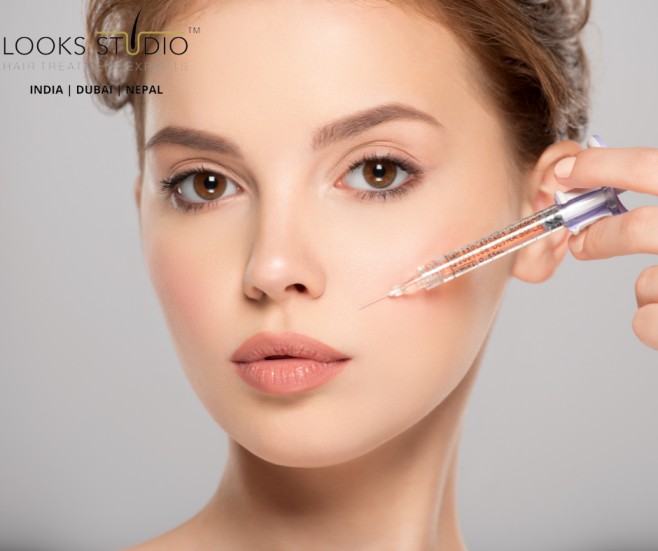Dysport vs Botox are popular treatments to prevent and treat fine lines and facial wrinkles. At Looks studio we perform both treatments wherein our Aesthetic Physician decides which is the better option for you. The question is, which is the best botox for the face?
Here we discuss the benefits of each treatment so that you can make an informed decision about what to do during your appointment in Looks Studio.
Botox and Dysport are FDA-approved neuromodulators or neurotoxins (forms of botulinum toxin type A) for minimizing fine lines and facial wrinkles.

Botox and Dysport both treat facial wrinkles, but there are a few notable differences.
This blog post looks at the similarities and differences between Botox and Dysport and guides you on how each neuromodulator can be best used based on your wants and needs.
What is Botox treatment?
Botox is a neurotoxin that prevents muscle contractions for up to four months and is most commonly used to treat fine lines & face wrinkles.
Now the question is: What are the 3 areas for Botox in the face?
Botox Injection
To experience the benefits of Botox for wrinkle relaxation, Botox must be injected into three keys of the face (frown lines, crow’s feet, and forehead lines) by a highly skilled injector. After injection, the naturally derived toxin blocks nerve signals to your muscles, which results in a more relaxed and softer-looking face with fewer wrinkles.
Botox may take longer to show results, but the effects of Botox last for four months on average. Regular injections every 3-4 months help maintain these results.
What is Dysport treatment?
Dysport is a neurotoxin that can help minimize wrinkles, just like Botox. Dysport reduces the appearance of lines that primarily affect the glabella, the area in between your eyebrows. These frown lines extend upward, or vertically, toward the forehead, especially when a person frowns.
Mechanism Of Action
Dysport works by blocking nerve signals that signal between your brain and facial muscles to prevent muscle contractions and is a temporary solution for wrinkles. Dysport may take less time to show results, but the effects of Dysport last for four months on average. After that, regular injections every 3-4 months help maintain these results.
What are the similarities between Botox and Dysport?
Botox and Dysport are neuromodulators or neurotoxins (forms of botulinum toxin type A) that the FDA has approved to minimize fine lines and wrinkles. Both Botox and Dysport paralyze muscles in your face and cause lines and wrinkles. Injecting Botox or Dysport into a targeted muscle area temporarily blocks the nerve impulses that control muscle contraction. The resulting lack of movement and the relaxation of muscles minimizes the appearance of wrinkles in the area.
The results of both Botox and Dysport are temporary. After some time, nerve impulses reach the treated area again, resulting in both muscle contractions and the reappearance of wrinkles and lines. However, with the help of an experienced injector, you can maintain the positive results of Botox or Dysport with regular treatment sessions approximately every 3-4 months.
Read- 7 Wonders of Botox: The Surprising Benefits of Botox Anti-Aging Treatment
What are the differences between Dysport vs Botox?
Molecule size:
Compared to Botox, the Dysport formula contains smaller molecules. Smaller molecules enable Dysport to work faster than Botox and a larger area of spreading, which is beneficial in some areas of the face. That is why it is essential to go to a provider who has lots of experience and expertise in proper dosing and placement of your Botox or Dysport.
Diffusion:
Dysport spreads out more than Botox does. After injection, Dysport can spread to a broader area. Therefore, Dysport is beneficial when addressing larger treatment areas such as forehead wrinkles. However, this diffusion means Botox can be more effective in treating smaller areas where more precision is needed or areas with thicker muscles.
Onset:
Dysport has the quickest “onset” of action than Botox, typically requiring 24 hours for all results to be realized. Botox can take up to 72 hours for results to fully establish
Dysport vs Botox: which one should you choose?
Choosing the proper treatment can be a difficult decision.
- It’s essential to find out all you need to know before making your final choice, and that is why Looks Studio Aesthetic Physicians are here for you.
- Botox and Dysport are both FDA-approved neuromodulators with similar effects, so the decision ultimately comes down to what’s best for your needs.
- Botox and Dysport are both safe when used as intended. However, there are some common side effects of botox and Dysport to consider when using this treatment. Minor swelling, redness, and itching at the injection site may occur. Droopy eyelids or muscle spasms are rare, with moderate side effects.
- Botox is perfect for people who want a more gradual result or those looking for a reduced frequency of treatment sessions since it takes longer than Dysport to take effect.
Conclusion
In the end, the choice between Botox and Dysport comes down to the preference of the injector and the patient. Some injectors may use both Botox and Dysport during a single treatment session to promote optimal results.
A consultation with our Aesthetic Physicians at Looks Studio branches will give you all of the information necessary to help you choose which neurotoxin, Botox or Dysport, is best suited for you.
